Michael Hoban closes out his series on the CAWS Career Gauge with this last installment identifying the players, both those who achieved Hall-worthy career performance as measured by CAWS and those who did not. More after the jump.
There are one hundred four (104) position players and forty-eight (48) pitchers in the live ball era (since 1920) who have Hall of Fame numbers according to the CAWS Career Gauge. Here is the distribution by position.
- First Base – 16
- Second Base – 14
- Third Base – 10
- Shortstop – 13
- Left Field – 14
- Center Field – 11
- Right Field – 12
- Catcher – 12
- Designated Hitter – 2
- Pitcher – 48
The rest of this post identifies those players who achieved, or came close to achieving, Hall of Fame-worthy careers as measured by the CAWS Career Gauge. For an introduction to CAWS, please see Part 1. For an explanation of Hall of Fame standards as measured by CAWS, please see Part 2.
The following lists will show the career totals for those players who had HOF numbers at each position. All numbers include the 2018 season, and will show:
- Bold print = Hall of Famer
- Italic = active player in 2019
- Career Win Shares from Bill James’ Win Shares formulae
- Core Value = sum of Win Shares for 10 best seasons
- CAWS = Core Value + .25 x (Career Win Shares – Core Value)
- CAWS+ = normalized CAWS where 100 = CAWS positional HOF-qualifying standard
Right Field (CAWS = 280)
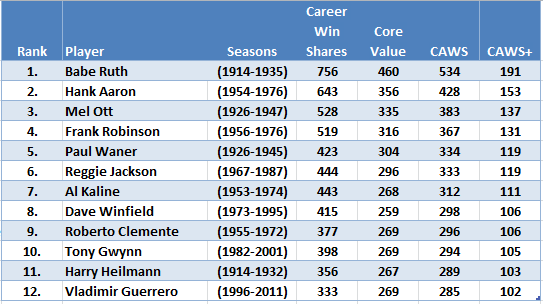
Note that all of these players have been elected to the Hall of Fame.
Left Field (CAWS = 280)
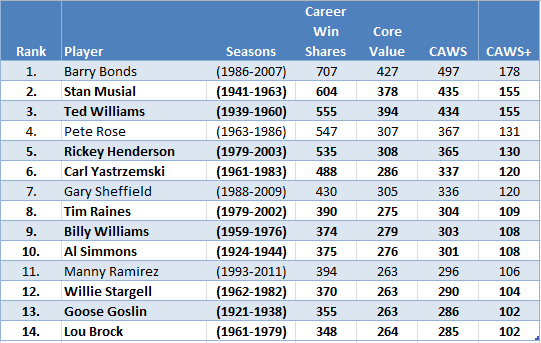
Note that of the players not elected to the Hall of Fame, one (Rose) is ineligible (banned) and the three others have been suspected of PED usage.
Center Field (CAWS = 270)
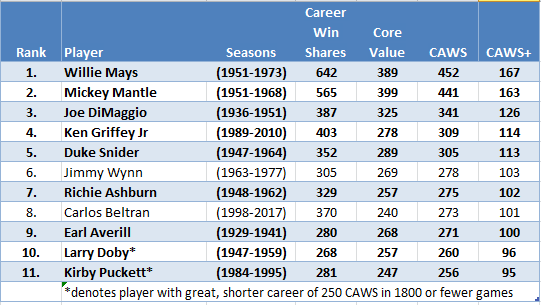
Of the two players not elected to the Hall of Fame, one (Beltran) is not yet eligible.
First Base (CAWS = 280)
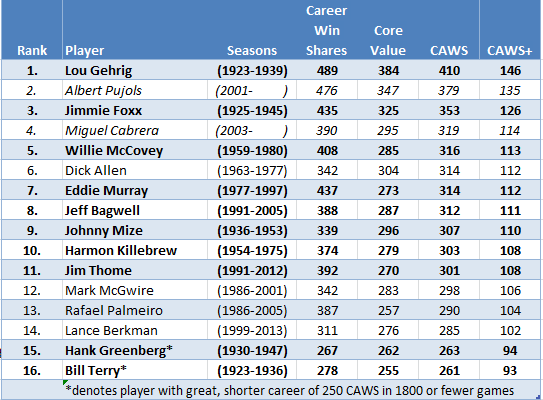
Two of the players not elected to the Hall of Fame are still active, one (McGwire) has admitted PED use, and a fourth (Palmeiro) is suspected of PED use.
Second Base (CAWS = 260)
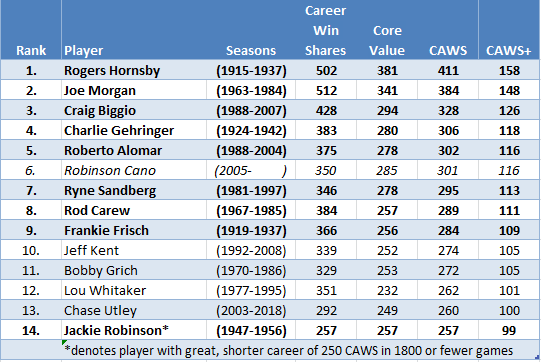
Of the players not elected to the Hall of Fame, one is not yet eligible (Utley), and one is active but has been suspended for PED usage.
Third Base (CAWS = 270)
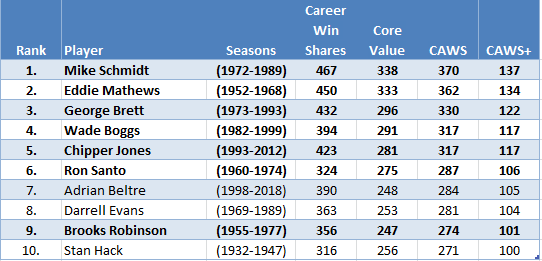
One of the players not elected to the Hall of Fame is not yet eligible (Beltre). Two other third basemen compiled HOF-qualifying great, shorter careers of 250 CAWS in a career of 1800 or fewer games: Heinie Groh (272 career Win Shares/243 core value/250 CAWS); and David Wright (267/247/252).
Shortstop (CAWS = 250)
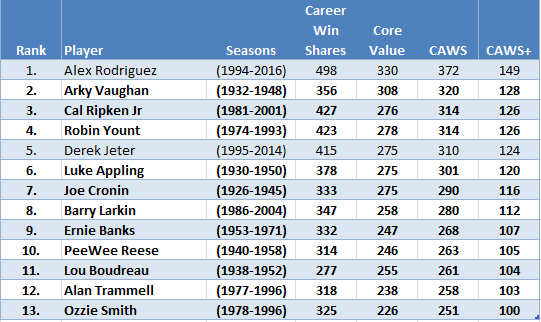
Both of the players not elected to the Hall of Fame are not yet eligible, though one (Rodriguez) has been suspended for PED usage.
Catcher (CAWS = 250)
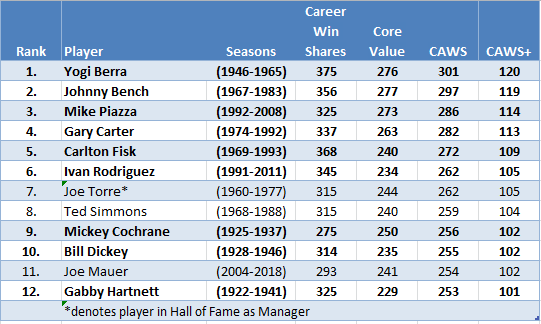
One of the players not elected to the Hall of Fame is not yet eligible (Mauer).
Designated Hitter (CAWS = 280)

Both of these players are in the Hall of Fame with solid credentials.
Pitcher (CAWS = 220)
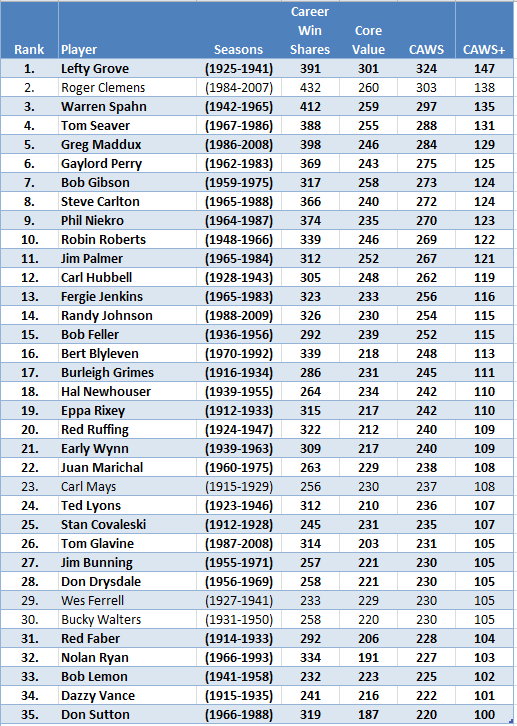
Only four of these players are not the Hall, one of whom (Clemens) is suspected of PED usage.
In addition to the players above, the following pitchers have Hall of Fame numbers according to the CAWS Career Guage, despite not reaching 220 CAWS.
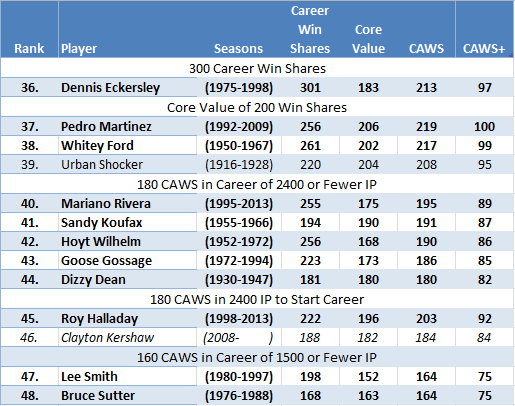
Only one retired and and one active player are not in the Hall among this supplementary list of CAWS-qualifying pitchers.
The Very Good
With any ranking system, there will be very good players who fall just short of the mark. Here are some of those players, by position.
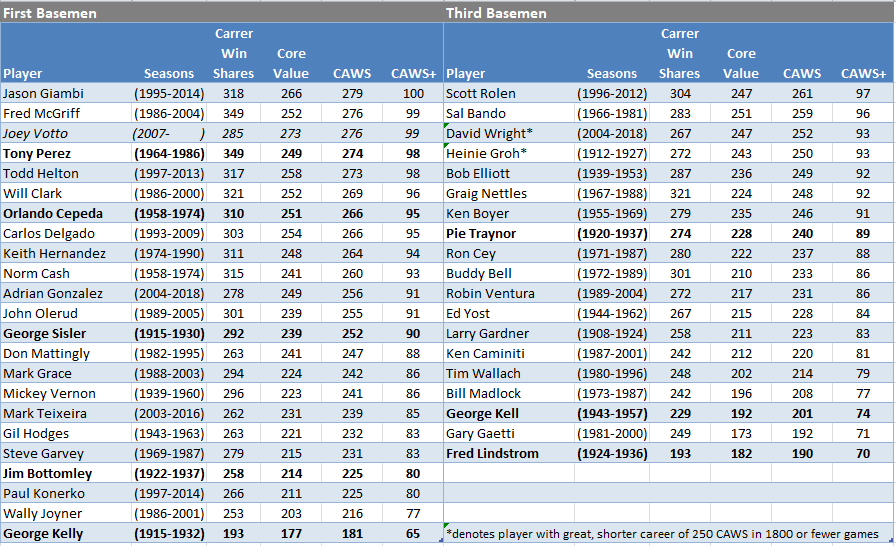
Only a handful of corner infielders not qualified by CAWS are Hall of Fame selections. Note that Joey Votto has, this season (2019), reached Hall of Fame qualifying levels for CAWS.
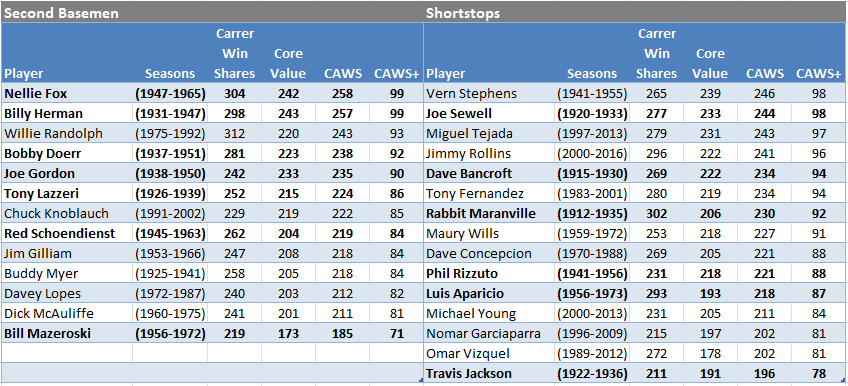
In contrast to the corner infielders, there is a larger proportion of middle infielders not qualified by CAWS who have been honored with Hall enshrinement. Most of them, though, are “in the conversation” with CAWS+ scores of 90 or more.
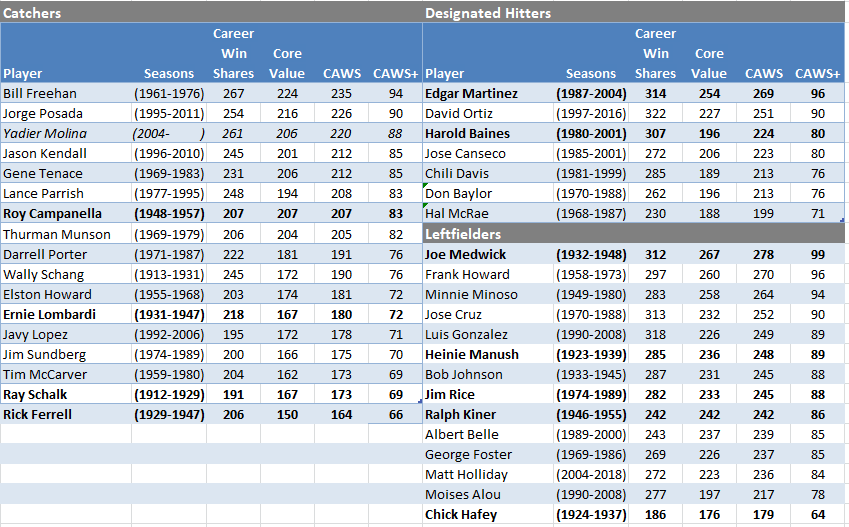
A couple of almost qualifiers (Martinez and Medwick) are among the non-qualifying HOFers for these positions. But there are several quite dubious Hall picks among the rest, with some allowance given for Roy Campanella‘s unique circumstances. Yadier Molina will likely pass Posada, and possibly Freehan, but most likely will not reach the 250 HOF qualifier.
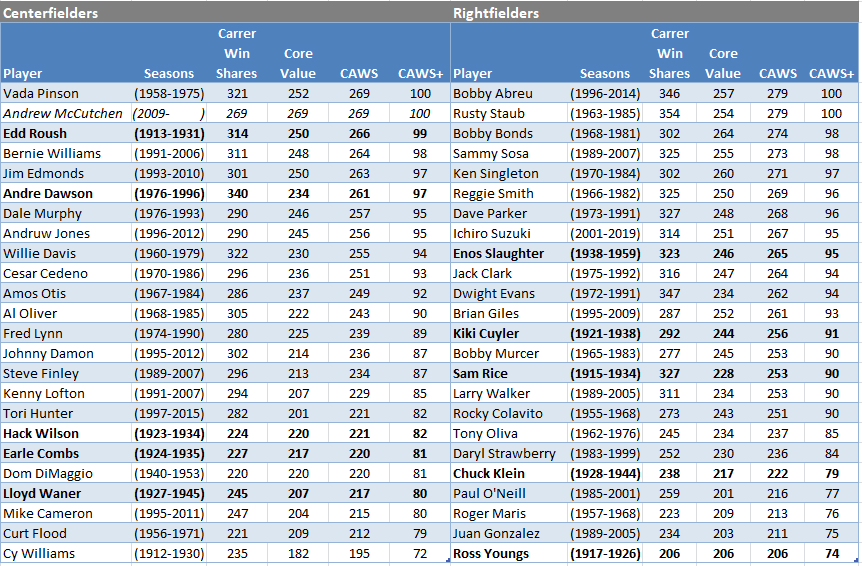
A sizable number of players here at the more demanding of the outfield positions, with a smattering of non-qualifying HOFers, half with CAWS+ of 90 or more, but the other half below that mark. Note that Andrew McCutchen has, this season (2019), reached Hall of Fame qualifying levels for CAWS.
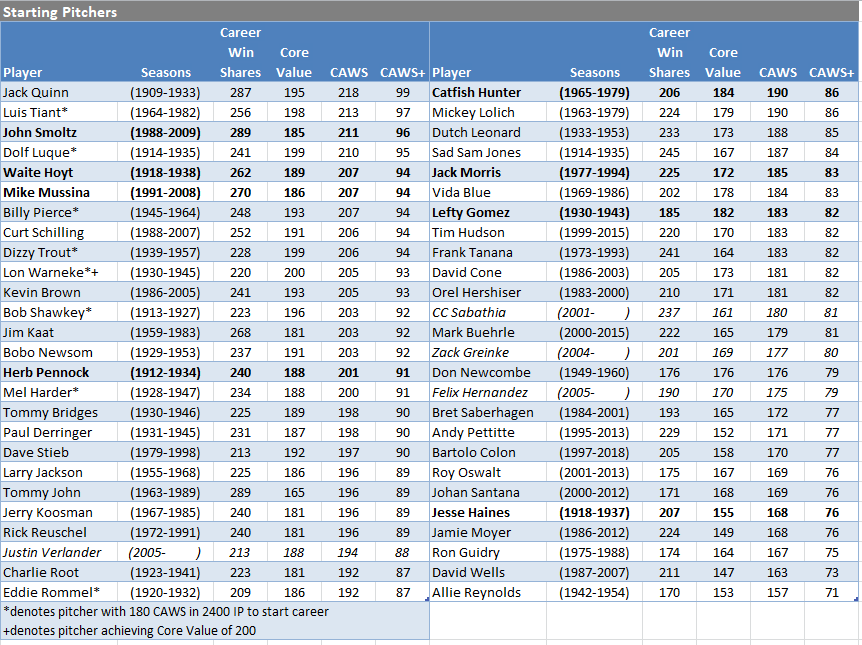
Similar story with starting pitchers, with only a couple of handfuls of Hall inductees among the non-qualifiers, half with better CAWS+ (on the left) and lesser lights on the right. Note the active pitchers on this list, one (Verlander) seemingly with a good chance of reaching 220 CAWS, the others much less likely. Note also the asterisked players, who achieved the CAWS qualification which admitted Roy Halladay (including Lon Warneke who also achieved the 200 Core Value qualification), but whom Michael has elected not to include among those pitchers with HOF-caliber credentials.
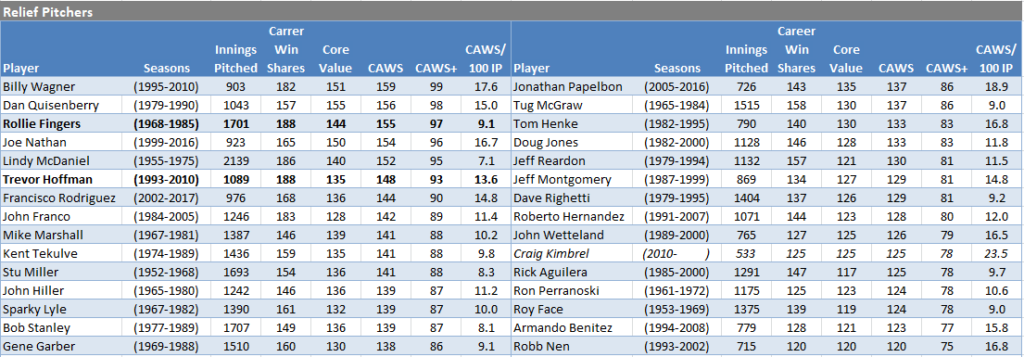
Finally, the relief pitchers with, perhaps surprisingly, only one active pitcher making the list. But, that pitcher (Kimbrel) easily outclasses all of the others in the CAWS per 100 IP metric.
For those who may be interested, I’ve prepared a spreadsheet of Career CAWS scores for all of the players in the Baseball Gauge database. The data presented are based on Win Shares as calculated by Baseball Gauge, which may not always match the Win Shares as shown on Bill James’ website. There are two calculations for Career Win Shares (CWS), Core Value (CV) and CAWS, one with no rounding of seasonal Win Shares totals, and one with rounding of each season’s Win Shares to a whole number. You can also download seasonal data for each player from this link.
